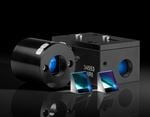Anamorphic Prism Pairs
Most laser diodes produce elliptically-shaped beams with different divergence angles in the x and y axes because of the rectangular shape of the diode’s active region (Figure 1). This is detrimental in many applications, as elliptical beams will have a larger focused spot size than circular beams. Larger spot sizes lead to a lower irradiance (flux of radiant energy per unit area) at the point of focus, which in turn may require a higher power input to the laser. Anamorphic prism pairs are particularly useful for circularizing elliptical beams.

Figure 1: The geometry of laser diodes causes them to produce elliptical beams with two different divergence angles.
An anamorphic prism pair consists of two right angle prisms used to reshape a laser beam.1 They are most often used to transform elliptical beams into circular profiles, but they can also produce other elliptical beam profiles in a range of sizes. The optical principle at play behind the reshaping is refraction; the light is bent in one direction, or one axis, while the other axis is kept constant (Figure 2). This compensates for the different divergences of the original beam.

Figure 2: An anamorphic prism pair acting as a beam expander in one direction, which can circularize an elliptical beam.
While a single prism could change the beam radius in one axis, it would also change the beam direction. A pair of prisms is required to manipulate the ellipticity of the beam while maintaining the original direction of propagation (Figure 2). However, using anamorphic prism pairs requires precise angular alignment. Although it is not required, it is useful for one prism to be oriented at Brewster’s angle, which is the angle of incidence at which there is no reflection of p-polarized light. The other surface of the prism should be at normal incidence and should be anti-reflection (AR) coated for maximum throughput. This precise measurement is why customers most often buy them as a pre-aligned pair.
Higher-end diodes often have anamorphic prism pairs built into the laser head for beam circularization. However, many lower cost diodes do not. The cost of purchasing a diode without an integrated prism pair and a separate anamorphic prism pair is often less than that of a more expensive diode.
Comparison to Cylinder Lenses
Cylinder lenses, which only have optical power in one direction, are also commonly used to circularize elliptical beams (Figure 3). A cylinder lens manipulates light by focusing it, or changing the wavefront curvature. Therefore, anamorphic prisms are more advantageous in low wavefront distortion applications.
Cylinder lenses have more degrees of freedom than mounted anamorphic prism pairs, making them more difficult to align. Cylinder lenses may tilt, making prisms more forgiving when aligning axes independently. Close attention must also be paid to the focal length of cylinder lenses so that they are the correct distance away from the diode output to produce a collimated circularized beam. Mounted anamorphic prism pairs are more user friendly. They are pre-aligned to have a fixed expansion power, so you do not need to position and assemble them yourself like you would with cylinder lenses. There is only one axis to which the prisms must be independently aligned because you are merely sliding the prism into the beam path. This removes an additional alignment step, saving the user time and potential frustration. The physical position of the anamorphic prism pair, relative to the location of the incident laser beam, is also less sensitive.

Figure 3: Two cylinder lenses being used to circularize an elliptical beam by acting on the x and y axes independently.
However, the extra degrees of freedom of cylinder lenses give them more flexibility, which may be useful in research applications and prototyping. They can also provide a higher throughput than anamorphic prism pairs, especially when using AR coatings. Light travels through less material in cylinder lenses compared to anamorphic prism pairs, and p-polarized light will be lost if prisms are used at Brewster’s angle. You can learn more about cylinder lenses at our Considerations When Using Cylinder Lenses application note.
| Cylinder Lenses | Anamorphic Prism Pairs | |
| Beam displacement | Not displaced | Displaced |
| Degrees of freedom | High | Low |
| Alignment sensitivity | High | Low |
| Throughput | High | Medium |
| Cost | Low | Low |
| Footprint | Small | Small |
Table 1: Comparison of cylinder lenses and anamorphic prism pairs for beam circularization.
Anamorphic Prism Pairs at Edmund Optics®
Edmund Optics offers mounted, unmounted, and variable anamorphic prism pairs available with broadband or laser line AR coatings for common diode wavelengths. The variable anamorphic prism pairs are mounted but allow the user to adjust magnification over a set range.
 Anamorphic Prism Pairs
Anamorphic Prism Pairs

- Converts Elliptical Beam to Circular
- Anti-Reflection Coated for Common Diode Wavelengths
- Mounted and Unmounted Versions Available
BUY NOW.
References
- Paschotta, Rüdiger. Encyclopedia of Laser Physics and Technology, RP Photonics, October 2017, www.rp-photonics.com/encyclopedia.html.
- Shapeoptics: Anamorphic Prism Pairs Shapes the Laser Beams. (2020, March 23). Retrieved June 15, 2020, from https://shapeoptics.com/anamorphic_prism/
















or view regional numbers
QUOTE TOOL
enter stock numbers to begin
Copyright 2023 | Edmund Optics, Ltd Unit 1, Opus Avenue, Nether Poppleton, York, YO26 6BL, UK
California Consumer Privacy Act (CCPA): Do Not Sell or Share My Personal Information
California Transparency in Supply Chains Act